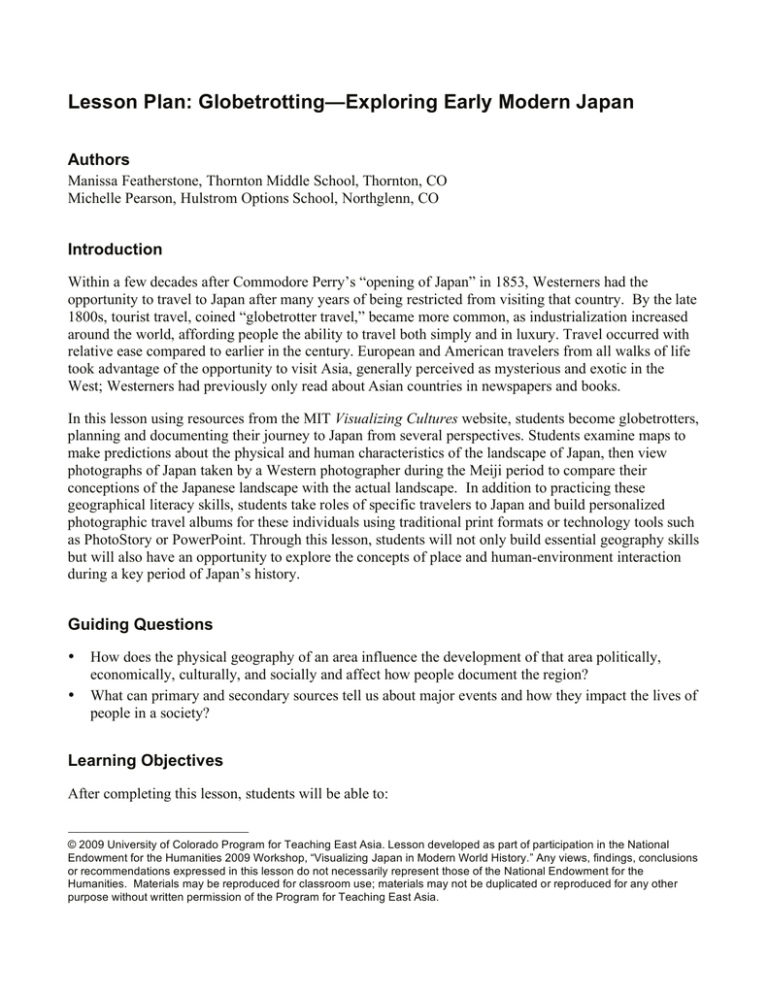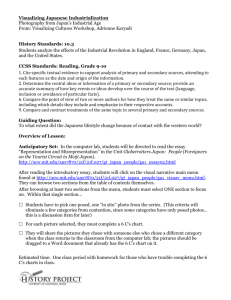Lesson Plan - University of Colorado Boulder
advertisement

Lesson Plan: Globetrotting—Exploring Early Modern Japan Authors Manissa Featherstone, Thornton Middle School, Thornton, CO Michelle Pearson, Hulstrom Options School, Northglenn, CO Introduction Within a few decades after Commodore Perry’s “opening of Japan” in 1853, Westerners had the opportunity to travel to Japan after many years of being restricted from visiting that country. By the late 1800s, tourist travel, coined “globetrotter travel,” became more common, as industrialization increased around the world, affording people the ability to travel both simply and in luxury. Travel occurred with relative ease compared to earlier in the century. European and American travelers from all walks of life took advantage of the opportunity to visit Asia, generally perceived as mysterious and exotic in the West; Westerners had previously only read about Asian countries in newspapers and books. In this lesson using resources from the MIT Visualizing Cultures website, students become globetrotters, planning and documenting their journey to Japan from several perspectives. Students examine maps to make predictions about the physical and human characteristics of the landscape of Japan, then view photographs of Japan taken by a Western photographer during the Meiji period to compare their conceptions of the Japanese landscape with the actual landscape. In addition to practicing these geographical literacy skills, students take roles of specific travelers to Japan and build personalized photographic travel albums for these individuals using traditional print formats or technology tools such as PhotoStory or PowerPoint. Through this lesson, students will not only build essential geography skills but will also have an opportunity to explore the concepts of place and human-environment interaction during a key period of Japan’s history. Guiding Questions • • How does the physical geography of an area influence the development of that area politically, economically, culturally, and socially and affect how people document the region? What can primary and secondary sources tell us about major events and how they impact the lives of people in a society? Learning Objectives After completing this lesson, students will be able to: © 2009 University of Colorado Program for Teaching East Asia. Lesson developed as part of participation in the National Endowment for the Humanities 2009 Workshop, “Visualizing Japan in Modern World History.” Any views, findings, conclusions or recommendations expressed in this lesson do not necessarily represent those of the National Endowment for the Humanities. Materials may be reproduced for classroom use; materials may not be duplicated or reproduced for any other purpose without written permission of the Program for Teaching East Asia. • • • • Locate cities in Japan on physical and political maps. Describe the physical and human characteristics of a variety of locations in early modern Japan. Use primary sources to create a personalized travel narrative of a journey in early modern Japan. Determine and use perspective in creation of a product based on primary sources. Background Information for the Teacher A wealth of background information related to this lesson can be found on the Visualizing Cultures website. Written by Allen Hockley, Professor of Art History, Dartmouth College, the essay accompanying “Globetrotters’ Japan: Places” provides concrete and succinct background on the information and resources used in this lesson. All four sections of the essay are recommended reading for teachers. Additionally, embedded in the essay are resources that can be used for extension activities to this lesson and others available on the MIT website. Preparing to Teach This Lesson • • • • • • Download and print Handouts 1-5 for all students. Download and print the Role Cards. You will need enough copies of each card for one-eighth of the class. Locate several political and physical maps of early modern Japan or contemporary Japan. Post the maps around the classroom or make enough copies for students to use the maps at their desks. A number of maps are available from the Perry-Castaneda Map Collection at the University of Texas. Select an appropriate assessment(s) for use with students. Prepare any materials needed for the assessment(s) selected. Secure technology resources for the lesson and bookmark appropriate websites on both student and teacher computers. Ensure that word processing software, PhotoStory, iMovie, Voice Thread, and/or other software students will need for their albums is loaded on group or individual computers and the teacher machine. Set up the computer and LCD projector so you can preview the image gallery with students. If you elect to complete the student album in print format, rather than using technology, print appropriate images from the Visualizing Cultures website and copy for use by student teams. Images can be found at the “Globetrotters’ Japan: Places” image gallery. Secure appropriate art supplies and materials so students can complete their album in print format. Lesson Plan 1. Display or distribute several political and physical maps; you can use historical maps or current maps available online or in atlases. Ask students to hypothesize what various locations in Japan looked like in the late 19th century. Listed below are some guiding questions that might be helpful during this activity: • What do you imagine would have been in this place based on the maps you are looking at? Consider all of your senses. © 2009 Program for Teaching East Asia 2 Based on your careful examination of these resources, what do you know about the physical landscape of Japan? • Where would you like to travel based on the maps you have looked at? • How hard or easy do you feel the travel would be based on your knowledge of the late 19th century? Have students use the maps to complete Handout 1. Show students the opening page of Allen Hockley’s essay, which explains the “Globetrotter” phenomenon. Next, explain that students will be using the image gallery in “Globetrotters’ Japan: Places.” Demonstrate how to navigate through the image collection, giving students some background on the images as you do so. It will be important for students to understand the role of photography and the souvenir album. Distribute Handout 2 and go over the task sheet with students. Assign roles to students by distributing the Role Cards. The roles are: • Scientist • Missionary • Family Traveler • Dignitary • Architect • Military Officer • Independent Explorer • Freelance Photographer Explain that, based on their roles, students will create their own albums of images providing a written and visual narrative of their journey. Explain the materials and/or software available for student use in creating their albums. Students can work individually or in small groups with other students assigned the same role. Provide copies of the rubric (Handout 3) by which students’ work will be assessed. Point out that the maps used in the earlier phase of the lesson will be useful in plotting their travels. Allow time for students to complete their work. Convene students as a large group and have each group present their album based on their role. If students worked individually, you may want to have the presentations done in jigsaw style; that is, you may create several smaller groups including students representing each of the roles. Presentations can then be made in these smaller groups. Students not presenting should take notes on the presentations using the note-catcher provided in Handout 4. Review the guiding questions for follow-up discussion with students, discussing their idea of Japan and place based on the presentations. The questions below may be useful in prompting discussion: • How did your role affect the destinations you chose to include in your journal? • How does what you know now about the landscape of Japan compare to what you hypothesized when viewing only the maps? • What do you still not understand about Japan in the 19th century after this activity? What more do you want to know? Have students complete the individual reflection sheet (Handout 5) to conclude the activity and provide feedback. • 2. 3. 4. 5, 6. © 2009 Program for Teaching East Asia 3 Assessments Students can be assessed on the completion of their photographic album from the perspective of a traveler to Japan. Student note-catchers, prediction sheets, reflections, and participation in class and group discussions can also be evaluated. In a short oral or written quiz, students could create three key descriptors of Japan’s physical geography based on what they have learned during this lesson. Extending the Lesson 1. Ask students to create a personal narrative as a traveler to Japan during this period, using a traditional five-paragraph essay or a constructed-response format to support state literacy standards. 2. Introduce students to the early 20th-century postcards on the Museum of Fine Arts Boston website and assign them to create a postcard highlighting this region from their role’s perspective. The postcard should entice visitors to Japan. 3. Globetrotters often carried curios or mementos home with them from their trip. Later, as tourism increased on a larger global scale, many businesses had their logos made into stickers, which were collected and placed in albums, on trunks, and on suitcases. Have students create a sticker for Japan based on what they have learned about the country from their studies. 4. Challenge students to find contemporary photographs of Japan. Such photos can be located from a variety of sources including travel brochures, blogs, sites on Flickr, etc. Ask students to compare and contrast these photos with the images from early modern Japan. Discuss the similarities and differences and the reasons for the continuities and changes students noted. Additional Information Grade Level: Grades 6-11 Subject Areas: Geography, History, Language Arts Time Required: 3-4 class periods of 50 minutes each Skills: • • • • • Analyzing primary sources. Making predictions. Interpreting, synthesizing, and applying information. Map reading. Drawing conclusions. NCSS Standards Alignment: I – Culture III – People, Places, and Environments © 2009 Program for Teaching East Asia 4 IX – Global Connections Student Handouts Handout 1: Using Maps to Gain Understanding of Japan Handout 2: Album Task Sheet: Becoming a Globetrotter in Early Modern Japan Handout 3: Group Work/Presentation Rubrics Handout 4: Note-catcher for Globetrotter Travel Album Presentations Handout 5: What Have I Learned: Reflecting on the Globetrotter Experience Role Cards Links to Online Sources “Japan Maps,” Perry-Castaneda Map Collection at the University of Texas: (http://www.lib.utexas.edu/maps/japan.html). “Globetrotters’ Japan: Places; Foreigners on the Tourist Circuit in Meiji Japan” essay by Allen Hockley: http://ocw.mit.edu/ans7870/21f/21f.027/gt_japan_places/ga2_essay01.html “Image Gallery” in “Globetrotters’ Japan: Places”: (http://ocw.mit.edu/ans7870/21f/21f.027/gt_japan_places/imgal_home.html). Links to Additional Online Resources (for Teacher Background or Extensions) “Felice Beato’s Japan: Places”: http://ocw.mit.edu/ans7870/21f/21f.027/beato_places/fb1_visnav01.html “Felice Beato’s Japan: People”: http://ocw.mit.edu/ans7870/21f/21f.027/beato_people/index.html “Globetrotters’ Japan: Places”: http://ocw.mit.edu/ans7870/21f/21f.027/gt_japan_places/index.html “Globetrotters’ Japan: People”: http://ocw.mit.edu/ans7870/21f/21f.027/gt_japan_people/index.html Historic Travel Sticker Resources: http://store.doverpublications.com/0486421945.html Japanese Postcards, Museum of Fine Arts, Boston: http://www.mfa.org/collections/sub.asp?key=22&subkey=114 W.E.L. Keeling’s Tourist Guide: http://ocw.mit.edu/ans7870/21f/21f.027/gt_japan_places/tg_01.html © 2009 Program for Teaching East Asia 5
